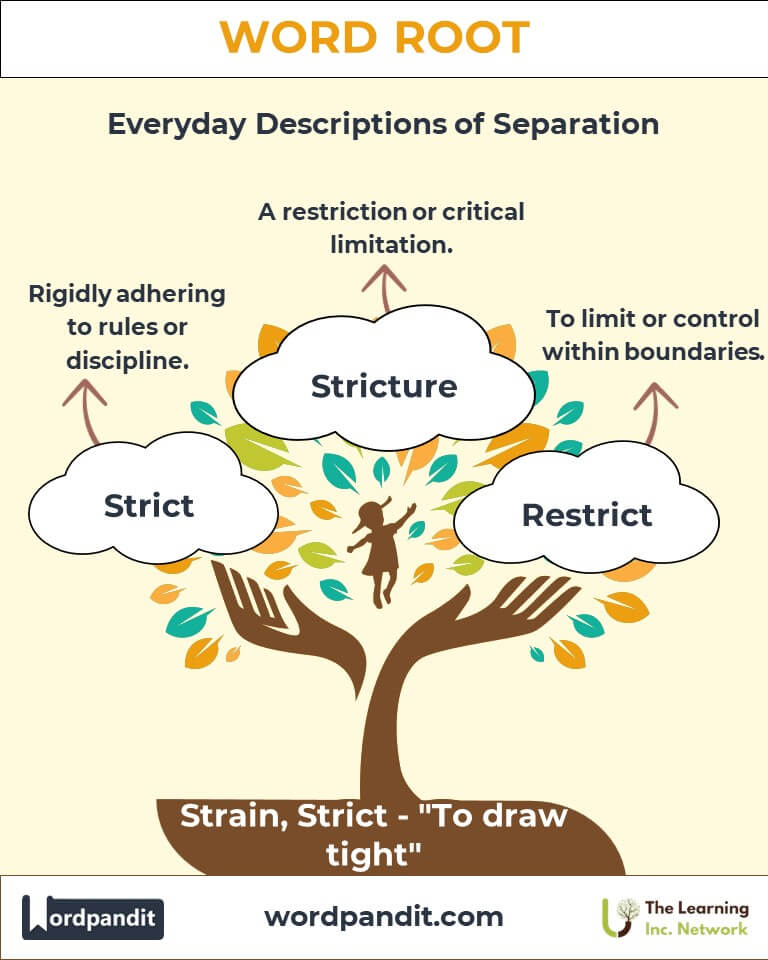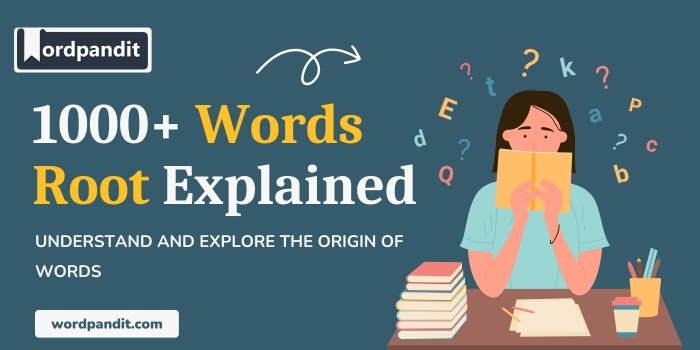Strain & Strict: The Roots of Tension and Tightness in Language
Explore the powerful roots "strain" and "strict," derived from the Latin word stringere, meaning "to draw tight." These roots form the foundation of numerous words that convey ideas of tension, control, and discipline, spanning everyday language and specialized fields.

Table of Contents
- Introduction: The Essence of "Strain" and "Strict"
- Etymology and Historical Journey
- Mnemonic: Unlocking the Power of "Strain" and "Strict"
- Common "Strain" and "Strict"-Related Terms
- "Strain" and "Strict" Through Time
- "Strain" and "Strict" in Specialized Fields
- Illustrative Story: "Strain" and "Strict" in Action
- Cultural Significance of "Strain" and "Strict"
- The "Strain" and "Strict" Family Tree
- FAQs About the "Strain" and "Strict" Word Root
- Test Your Knowledge: "Strain" and "Strict" Word Root Quiz
- Conclusion: The Living Legacy of "Strain" and "Strict"
1. Introduction: The Essence of "Strain" and "Strict"
What ties together concepts like pressure, discipline, and boundaries? The roots "strain" and "strict" both come from the Latin stringere, meaning "to draw tight" or "to bind." These roots have given rise to words that describe physical tension, emotional stress, and social restrictions. From "strain" in physical sciences to "strict" in rules and guidelines, their versatility highlights their central role in communication.

2. Etymology and Historical Journey
The Latin word stringere originally meant "to bind tightly" or "to draw tight." Over time, this root evolved into words across European languages, retaining its core meanings of tension, pressure, and constraint. In English, "strain" emphasizes tension and exertion, while "strict" conveys a sense of rigidity, order, and discipline.
3. Mnemonic: Unlocking the Power of "Strain" and "Strict"
Picture a rope being pulled tight under immense force, representing "strain," and a ruler enforcing straight, rigid lines, symbolizing "strict."
Mnemonic Device:
"Strain stretches under pressure, while strict sets boundaries with precision."
4. Common "Strain" and "Strict"-Related Terms
- Strain (strayn)
Definition: To exert effort or force to the point of tension.
Example: "The rope strained under the weight of the heavy load." - Restrict (ree-strikt)
Definition: To limit or control within boundaries.
Example: "The policy restricts access to sensitive information." - Constrain (kuhn-strayn)
Definition: To force or compel action within tight limits.
Example: "The tight schedule constrained their creative process." - Strict (strikt)
Definition: Rigidly adhering to rules or discipline.
Example: "The strict teacher enforced punctuality in her class." - Stricture (strik-cher)
Definition: A restriction or critical limitation.
Example: "The law imposed new strictures on environmental practices." - Stress (stres)
Definition: Pressure or tension, both physical and emotional.
Example: "The exam caused her a great deal of stress."
5. "Strain" and "Strict" Through Time
- Middle Ages: Stringere was used to describe binding, tightening, and controlling actions, such as tying ropes or enforcing laws.
- Renaissance: As scientific language developed, "strain" came to describe physical forces, while "strict" gained prominence in moral and religious contexts, emphasizing discipline and order.
6. "Strain" and "Strict" in Specialized Fields
Physics and Engineering
Strain: Measures deformation in materials under stress.
Example: "The strain gauge detected minute changes in the bridge's structure."
Medicine
- Muscle Strain: Injury caused by overstretching muscles or tendons.
- Stricture: Abnormal narrowing of a passage in the body, such as in the throat or intestines.
Sociology and Law
- Social Strain: Tensions arising from conflicting societal norms or expectations.
- Strict Liability: Legal responsibility that does not consider intent, enforcing rigid adherence to laws.
Music
Strain: A recurring melody or theme in a musical composition.
Example: "The joyful strain of the song uplifted everyone in the room."
7. Illustrative Story: "Strain" and "Strict" in Action
Sophie, a young architect, faced a dual challenge. She had to design a skyscraper capable of withstanding immense strain from wind forces while adhering to the strict building codes of the city. By applying her knowledge of structural engineering and precise regulations, she created a design that balanced flexibility and strength, winning praise for her innovative solution.
8. Cultural Significance of "Strain" and "Strict"
The roots "strain" and "strict" resonate deeply across cultures. From strained relationships in literature to strict societal norms in moral codes, these words reflect universal themes of effort, resilience, and boundaries. They highlight the balance between flexibility and control that defines human experience.

9. The "Strain" and "Strict" Family Tree
Related Roots and Their Connections:
- String- (tight, bind):
- Stringent: Imposing strictness or severity.
- String: A cord or thread under tension.
- Stress- (pressure, urgency):
- Distress: Severe suffering under pressure.
- Eustress: Positive stress that motivates action.
- Strict- (rigid, precise):
- Strictly: Done with complete adherence to rules or principles.
FAQs About the Word Roots "Strain" and "Strict"
Q: What do the roots "strain" and "strict" mean?
A: Both roots come from the Latin word stringere, meaning "to draw tight" or "to bind." "Strain" emphasizes tension, stretching, or pressure, while "strict" focuses on rules, boundaries, or discipline. Together, they represent concepts of tightness and control.
Q: How does "strain" relate to physical and emotional tension?
A: "Strain" in a physical sense refers to stretching or exertion that causes tension, like straining a muscle. Emotionally, it describes mental or emotional pressure due to stress or challenging situations, as in "strained relationships" or "feeling strained."
Q: What is the difference between "strain" and "stress"?
A: "Stress" is the force applied to an object, while "strain" is the deformation or change that results from that force. Similarly, in emotional contexts, "stress" is the external pressure, while "strain" reflects the internal effects of that pressure.
Q: What does "strict" mean, and how does it connect to discipline?
A: "Strict" relates to rigid adherence to rules or regulations. It emphasizes control and precision, ensuring discipline by enforcing tight boundaries or guidelines.
Q: How is "strain" used in science and medicine?
A: In physics, strain measures the deformation of a material under stress, a key concept in material science and engineering. In medicine, "strain" refers to injuries caused by overstretching muscles or tendons, such as a "hamstring strain."
Q: What is a "stricture," and where is it used?
A: A "stricture" is a restriction or narrowing. In medicine, it often refers to an abnormal narrowing of a passage in the body, such as the esophagus or intestines. In general language, it can mean a critical limitation or restriction.
Q: What does "restricted access" mean?
A: It means limited or controlled entry to certain areas, information, or opportunities. The term comes from the root "strict," emphasizing the imposition of boundaries.
Q: Why is "strain" used in music?
A: In music, "strain" refers to a recurring melodic theme or passage. This usage metaphorically draws on the idea of pulling or drawing out a melody.
Q: How does "strict" apply to social rules?
A: "Strict" rules are those enforced rigidly, often with no room for flexibility. They ensure order and discipline, whether in legal systems, parenting, or institutional policies.
Q: What is "strict liability" in law?
A: Strict liability is a legal principle where a person is held responsible for their actions or outcomes, regardless of intent or negligence. It highlights the idea of absolute adherence to certain rules, reflecting the root "strict."
Test Your Knowledge: "Strain" and "Strict" Mastery Quiz
1. What does the root "strain" signify?
2. Which word means "rigid adherence to rules"?
3. What is strain in physics?
4. What does "stringent" mean?
5. Which term describes a medical condition involving narrowing of a passage?
12. Conclusion: The Living Legacy of "Strain" and "Strict"
The roots "strain" and "strict" illustrate the universal concepts of tension and control, influencing words that describe effort, discipline, and boundaries. By exploring these roots, we gain a deeper understanding of how language reflects human experiences of pressure and precision. Let these roots inspire you to appreciate the balance between flexibility and order in both language and life.












